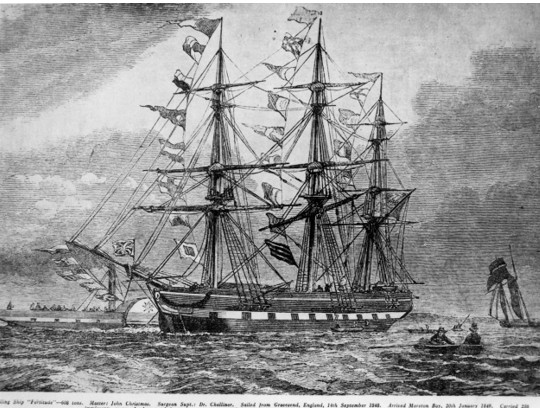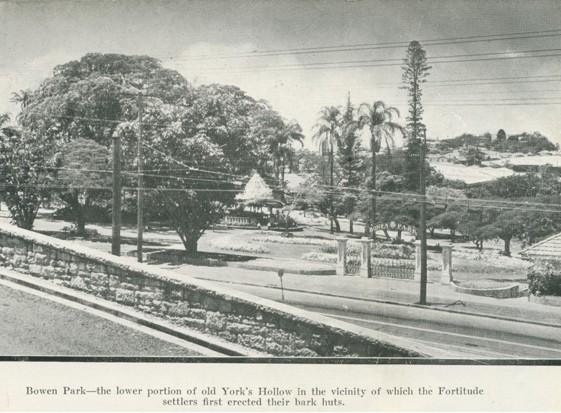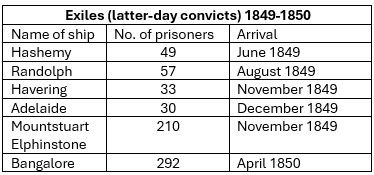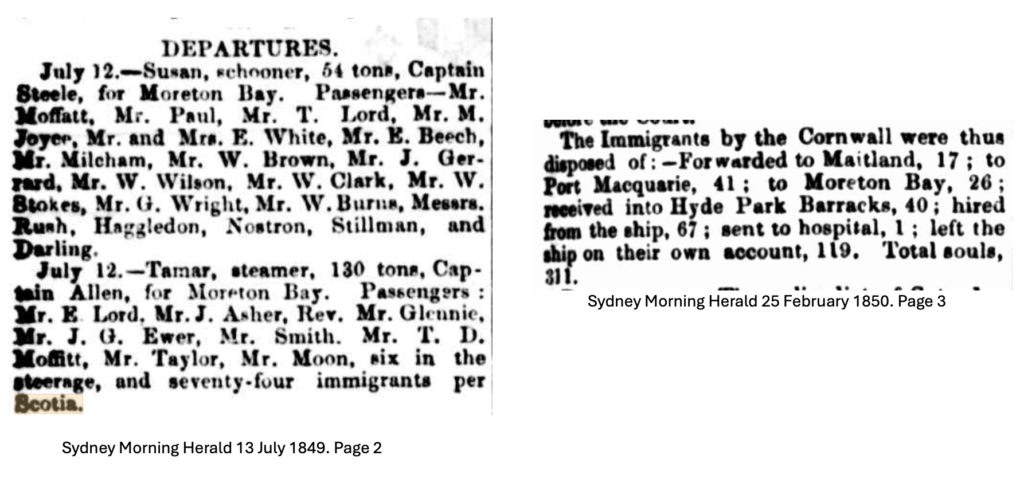Arrivals in Moreton Bay 1849-1850: a population boost with a difference
1849-1850 was a distinctive stage in the free settlement of Moreton Bay which had begun in 1842. For the first time significant numbers of people arrived in Brisbane, most not government assisted immigrants. Different groups created vigorous conflict which determined the colony’s future. They also necessitate checking various records to track their arrival.
When the government-assisted Artemisia, the first ship to bring immigrants direct to Moreton Bay came in December 1848, it brought news of the Fortitude’s imminent arrival, which eventuated on 21 January 1849. The local community rejoiced knowing a population boost was necessary to achieve Separation from New South Wales (NSW). The colony’s northern outpost was suffering from disinterest and neglect which independence could remedy. John Dunmore Lang saw potential in Moreton Bay. He actively encouraged colonists who were hard-working and skilled. He wanted Protestants, not necessarily Presbyterian, but sober, God-fearing citizens, not Catholics.

Fortitude ship State Library of Queensland Neg no: 75997.
Lang sought benefits from the Emigration Commissioners such as accommodation and sustenance on arrival as well as land grants, but the waiting time was too long for him. Confident that the Emigration Commissioners would ultimately support him and the immigrants, he and his charges set sail. Wickham, the Government Resident in charge of Moreton Bay, did not know how to respond to unauthorised arrivals. The Fortitude immigrants were dispatched to Yorks Hollow, outside the town, while Wickham sent a passenger list to Sydney and awaited instructions.
The government did not meet Lang’s promises to the immigrants however, they were so successful that we are familiar with Fortitude passenger names such as Slaughter, Cribb, Challinor, Childs and Pettigrew. Similarly, Chaseley passengers thrived without government aid. Lima passengers did get some land grant assistance.
Other arrivals were latter-day convicts. The Mountstuart Elphinstone (spelt variously) was in Sydney simultaneously with the Lima. Unlike previous convict arrivals into Moreton Bay, these convicts were not secondary offenders i.e. they had not committed further offences once in Australia and then been sent to Moreton Bay as a more severe punishment. The Mountstuart Elphinstone and the Bangalore were the only convict ships which came directly to Moreton Bay. The prisoners had served time in England and were given tickets-of-leave on arrival allowing them to move around within districts, but they were required to report for musters. Small groups of exiles were also sent from Sydney. They were called exiles because convict transportation had officially ceased along the east coast of Australia in 1840. They had been sent at the requests of graziers and agriculturists who sought cheap convict labour. This threatened Lang’s immigrants who saw their labour devalued and community standards threatened. The exiles of the Mountstuart Elphinstone and the Bangalore caused disruption. After time in gaol and months on a prison ship they cut loose in Brisbane with drunken rowdyism, theft and destruction. Although many moved west to work for landowners they strengthened the views of Lang’s sober immigrants against the re-introduction of convicts. After angry debates in the press, public meetings and letters to the British Government, the convict system ended on the eastern mainland although not in Tasmania or Western Australia.
Some immigrants travelled north to Brisbane. Southern over-employment could mean that, as recipients of a free passage, they could have been directed to the labour-hungry north. Others may have intended to come to Brisbane, but the only timely passage was via Sydney. In 1850 alone 300 arrived from the south.
The second government assisted immigrant ship direct to Moreton Bay came in 1850, nearly 2 years after the first. The ship, previously carrying guano, was inadequately cleaned. The outbreak of typhus resulted in a serious death toll on the journey and in the quarantine prepared hastily on Stradbroke Island.
Resources for finding arrivals 1849-1859
Lang immigrants were unassisted but the Fortitude passengers, along with those on government assisted passages direct to Moreton Bay or Sydney, can be identified initially in Assisted Immigrants Index 1839-1896. There are two lists for these immigrants: the immigration Board list and another for the Immigration Agent. Find the Agent’s list for a ship at Assisted immigrants digitised shipping lists 1828-1896. Search Ancestry for the Board’s list which also details parents in the home country. The Chaseley passengers are in a rewritten list in Assisted immigration 1848-1912. The only surviving Lima list is that from the reunion recorded in the Queenslander 13 May 1899 p880.
Moreton Bay exiles can be identified at Convict exiles index 1849-1850. Lists of names of those who came on the Mountstuart Elphinstone and Bangalore were published also in the Moreton Bay Courier accessible via Trove. The Index Australian Joint Copying Project Prison Commission registers, AJCP P. Com. 2, reels 5971-5991 provides British detail on the exiles, sometimes including names of a spouse or father. The references allow a free, online search of prison records at Series PCOM 2. Home Office and Prison Commission: Prison Records, Series 1, 1816 – 1866. The chaplain in his Journal of a voyage from England to Sydney and Moreton Bay in the Mount Stuart Elphinstone, 21 May – 8 Dec. 1849 Joseph Kidd Walpole gave his character assessment of each convict. Track the employment of those who went west on a CD-ROM, Initial settlement on the Darling Downs 1843-1852 a transcription of Rolleston’s records.
Those who arrived in Sydney but travelled north are listed on the coastal ship on which they travelled by number only, primarily in the NSW newspapers searchable using Trove historical newspapers.
Keyword search Colonial Secretary’s letters received relating to Moreton Bay using the descriptive index then follow the instructions to find documents online related to these arrivals.
Population increase
Brisbane’s newspaper noted the population increase in the northern NSW counties of which Brisbane was the heart.
Brisbane was on the path to Separation.








Another group of immigrants in this period where the Irish Orphan girls under the Earl Grey scheme. The first group arrived in Sydney aboard the Earl Grey in October 1848 and some came on to Brisbane.
My great great grandfather came on the Hashemy in 1849 – his future wife had arrived in October 1848 as part of the group from The Earl Grey.
Interesting article Stephanie, thank you
Thanks for your comments Michael and Christine. I was keen to draw attention to the arrivals in this period who are not easily checked.It’s great to know you are aware of this period.
Thank you Michael and Christine, for enlarging on the period.